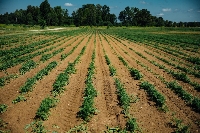At a time when climate change is becoming more and more visible in the daily lives of Latvians, Latvian Fund for Nature with their partners – Institute for Environmental Solutions, the Latvian Rural Advisory and Training Centre and the Czech Science and Society Center, continues to implement LIFE CRAFT: Climate Responsible Agriculture in Latvia. For the third year, agricultural practices that reduce greenhouse gas (GHG) emissions are being tested and practically demonstrated in Latvia. At the same time, this allow farmers to maintain economic stability and promote the competitiveness of climate-responsible agriculture in the market.
In 2020 at its season of the third year, when LIFE CRAFT actively continued field work, testing three climate-friendly farming methods, a group of artists joined the project. This group of artists have started work on an interdisciplinary art exhibition under the guidance of the Institute of Environmental Solutions, which will stimulate discussion about human attitudes and actions towards the environment, land, resources, climate change and people around.
Climate - friendly farming methods
“During the implementation of the LIFE CRAFT project, we practically test and demonstrate three different methods that are still rarely used in Latvia - direct sowing, bio-carbon incorporation into soil and controlled drainage, which allow reducing CO2 and other GHG emissions, by introducing them to Latvian farmers and compile practical recommendations for the application of these methods in Latvian conditions, ”says Laura Zvingule, project manager at the Latvian Fund for Nature.
In the third season of the project implementation field in 2020, the project farms continued to use the direct sowing method, sowing fields of 143 ha. To compare the results obtained during the project, fields are maintained in several farms, where the owners continue the traditional tillage. These fields have the same growing conditions and crops as the fields sown by the direct sowing method. The first results on the impact of direct sowing on reducing agricultural emissions are expected in the autumn of this year.
The incorporation of bio-carbon into the soil was further tested by three organic farms, where soybeans, onions, black radish, turnips and kale were grown in the study fields. In all three farms, bio-carbon is incorporated into the soil in four different concentrations, which will make it possible to compare the yield of the method in relation to the contribution of resources.
During the 2020 season, work also continued in fields where the controlled drainage method was tested. Last year, sensors were completely built and installed in 42 ha wide fields in Ogre region. Here it will be possible not only to obtain data on the effects of controlled drainage on agricultural yields, soil and climate, but also to compare them with an area in very similar conditions where this method will not be introduced.
Interdisciplinary art exhibition
In 2020, work began on developing the concept for an interdisciplinary art exhibition. The exhibition will raise issues of human-environmental relations through the dimensions of science, art, agriculture and education. Within the framework of LIFE CRAFT project, the exhibition is created by the Institute of Environmental Solutions together with a group of artists, researchers and curators. The curators emphasize that the main task of this exhibition is not to provide direct answers to environmental problems, but rather to ask questions about the environment and human interaction with it and to encourage oneself to constantly ask about actions, choices and systems in which to exist.
A team of artists and researchers representing various art media disciplines has been involved in the creation of the exhibition - ceramicist and designer Esmeralda Purvišķe, illustrator and muralist Zahars Ze, choreographers and dance artists association IevaKrish (performers Ieva Gaurilčikaite-Sants and Krišjānis Sants) together with swedish choreograpgher and performer Erik Erikson and installation and performance artist Linda Bolshakova, who combines the relations between art, science, environment and people cultural architect and urbanist Līva Kreislere, textile artist and environmental activist Sandra Kosorotova, curator and head of P. Stradiņš Museum of Medical History Kaspars Vanags, Baiba Prūse together with a group of ethnobotany researchers of the DiGe project led by Renata Sõukand, director and film researcher Julien Nuhum Kulibali in collaboration with 2Annas ISFF, curator of the exhibition artist and producer Aleksjs Koškins.
In 2020, the artists involved in the exhibition, visited the farms involved in LIFE CRAFT project, got acquainted with the farmers and studied the farming methods tested in the project. Collaboration with hosts and scientists of various disciplines also continues during the creation of works of art.
The exhibition, together with a scientific seminar on the research methods used in LIFE CRAFT project, will be on view in the summer of 2021 in Cēsis, at the Science and Art Center "Brūzis".

